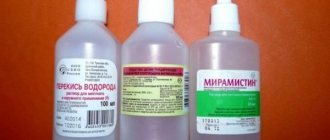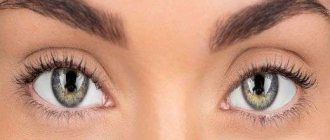The main component of Novocaine is the anesthetic substance procaine, which successfully relieves pain and reduces spasms of smooth muscles. Novocaine is produced in the form of an injection solution in ampoules of 2, 5 and 10 ml, in a package of 10 ampoules and instructions for use. Inside contains a 0.5% transparent, odorless solution.
The product can also be found in 100 ml bottles, as well as rectal suppositories. Novocaine for eyes should be used only for first aid.
Pharmacological properties
Novocaine is an anesthetic that is widely used in therapeutic practice. Its ability to block sodium channels and prevent the passage of nerve impulses allows it to be used to relieve pain, eliminate spasms, and reduce myocardial excitability.
When injected, the substance is easily absorbed, but its absorption through the mucous membranes is difficult.
The medicine has the following properties:
- provokes a slowdown in potassium flow;
- suppresses acetylcholine synthesis;
- reduces the excitability of nerve endings responsible for motor skills;
- eliminates spasms of smooth muscles.
These properties allow the drug to relieve pain and reduce the intensity of inflammatory phenomena.
Compared to Lidocaine, Novocaine has less intense analgesic properties. Due to this, it is less toxic and is used in the treatment of many diseases.
Pharmacological influence
The active component of the Novocain injection solution has a local anesthetic effect and leads to a decrease in all types of tissue sensitivity at the injection site. The therapeutic effect is realized by blocking sodium channels on the surface of peripheral nerves, which interferes with impulse conduction and generation in sensory fibers. After absorption of the active component into the systemic bloodstream, it produces a ganglion-blocking effect and reduces the excitability of the cholinergic peripheral systems of the nervous system. In addition, the drug reduces the excitability of the motor structures of the cerebral cortex and cardiac muscle (myocardium). The drug eliminates the descending inhibitory effect of the reticular formation of the brain and suppresses polysynaptic reflexes.
Indications for use of Novocain drops
In ophthalmology, the product has found its use for instillation into the eyes. Indications for use are:
- damage to the organs of vision, accompanied by intense pain;
- burns of the cornea by ultraviolet radiation, welding with the appearance of “bunnies” in the field of view;
- painful symptoms after certain cosmetic procedures;
- pain after laser and abdominal operations;
- pain due to inflammatory eye pathologies;
- carrying out diagnostic procedures, removing a foreign object from the eyeballs.
Novocaine is a product that should be in every home medicine cabinet. The drug can come to the rescue in any situation for quick pain relief.
In medical practice, Novocaine is used to relieve pain of various origins accompanying the following systemic diseases:
- pathologies of the gastrointestinal tract, including ulcers;
- problems with the duodenum;
- proctological diseases;
- diseases of joints and blood vessels;
- atherosclerosis.
Novocaine is used intravenously and intramuscularly for spinal, conduction, infiltration and epidural anesthesia.
In what cases are Novocaine drops used?
Novocaine is known among many as a remedy for welding bunnies, but in fact it is a fairly popular medical drug that has a wider scope of application. Firstly, it is used as an anesthetic for eye burns. This is the very remedy with which treatment begins. Secondly, diseases such as stomach ulcers, hemorrhoids, problems with the duodenum, perinephric blockade and other things also cannot be done without this remedy. It is also used in several types of pain relief. It could be:
- Spinal anesthesia;
- Epidural anesthesia;
- Conduction anesthesia;
- Infiltration anesthesia.
Contraindications to the use of Novocain drops
Novocaine is not used if you have hypersensitivity to procaine. Restrictions on use include children under 12 years of age.
Restrictions for introducing Novocaine into the eyes are:
- cataract;
- the occurrence of acute inflammation and pus in the organs of vision;
- pseudocholinesterase deficiency.
In special cases, the medicine can be used during pregnancy and breastfeeding, as well as in persons over 65 years of age under the supervision of a physician.
Require special care when injecting the substance:
- urgent surgical interventions accompanied by severe blood loss;
- progression of heart failure;
- poor hepatic blood flow;
- the presence of infections in the area of drug administration;
- severe heart disease.
What is prohibited?
Preventing deterioration is no less important than providing first aid in a timely manner. Under no circumstances should you:
- Rub your eyes when dirty, as well as in case of any kind of burn.
- Dropping substances whose effect on the eye itself, as well as possible interaction with ingested substances, you do not have a sufficient understanding of. For example, an attempt to extinguish an acid with a neutralizing solution entails the risk of a thermal burn from the heat released during the reaction. Do not use expired medications.
- Try to remove the speck that has got into the eye with hard objects, if this was not possible with a cotton swab or swab.
If it is not clear what to do, it is better not to do anything. If possible, keep the victim calm and call an ambulance immediately.
Dosage and order of use
Novocaine is not an ophthalmic agent and is not intended for the systematic treatment of eye diseases. However, in emergency cases, the medication is used as an instillation:
- open the ampoule with the drug, draw a small amount of the substance into the syringe using a needle or pipette;
- if you receive a burn after welding, the affected organ is washed with clean water;
- if metal shavings fly into the eye, remove them using a cotton pad;
- Using a pipette or a syringe without a needle, the product is injected into the eye in the amount of 1-2 drops.
The effect of the medicine occurs after 3-5 minutes and lasts for 4 hours. You can drip Novocaine into the organs of vision for up to 2 days, during which the victim should immediately contact a specialist to prescribe appropriate therapy.
Use in childhood
The medication should not be used as a pain reliever in children under 12 years of age.
In case of accidental burns or eye damage, children over 12 years old should instill 1 drop of the drug into each conjunctival sac. After this, you should urgently contact a pediatric ophthalmologist for advice.
During pregnancy and lactation
It is not recommended to use Novocain for pregnant and lactating women. However, sometimes it is used as an adjuvant intramuscularly for toxicosis accompanying hypertension in the later stages of pregnancy.
The substance is not able to penetrate through the mucous membranes into the systemic bloodstream and affect breast milk. Therefore, in special cases, it can be used as an anesthetic in the eyes, 1-2 drops in each eye.
Other eye drops
However, Novocain is not inherently an ophthalmic agent; it is intended for the treatment of inflammatory processes. Ophthalmologists most often prescribe the following medications for pain relief:
- "Octilia" - pain-relieving eye drops. Their main substance is tetrizoline, which produces a vasoconstrictor effect, reduces swelling, and reduces the synthesis of fluid in the eyes. The composition of the drug has an anti-inflammatory effect: linden and chamomile extract. "Octilia" acts after instillation for 4-8 hours. The product is often prescribed to people whose eyes have been damaged after welding work.
- "Alcaine." The advantage of the drops is that they act very quickly. Within thirty seconds after penetration into the conjunctival sac, the patient feels relief. However, this medication only lasts for twenty minutes. Its main active substance is proxymethocaine. The drops do not cause any side symptoms even with a large dosage, which is why it can be used frequently. Ophthalmologists consider Alcaine one of the most effective anesthetics and often prescribe it to patients.
- "Naklaf." These anesthetic eye drops are based on sodium diclofenac. This substance prevents the development of inflammatory processes and effectively eliminates pain syndrome. "Naklaf" is used in eye surgery. The drug does not enter the general bloodstream and does not cause side effects.
- "Indocollier." The active substance indomethacin provides the analgesic effect of the drops. In addition, it contains components that reduce the production of prostaglandins. The drug is absorbed into the blood, and therefore, when using other drugs for the treatment of the organs of vision simultaneously, it is necessary to take breaks.
Side effects of Novocain drops
Side effects after use include:
- decreased blood pressure, including collapse;
- the occurrence of weakness, drowsiness, dizziness;
- skin rash, allergic reactions;
- anaphylaxis;
- tachycardia;
- pain in the head and chest.
The medication is almost always well tolerated when applied topically. However, with individual sensitivity, negative effects may occur - redness of the mucous membranes, rashes around the eyes.
special instructions
Novocaine is not suitable for long-term use (more than 2 days). Its ability to provide a local anesthetic effect can lead to irritation of the cornea, the appearance of erosions and inflammation in the visual organs.
For longer-lasting anesthesia, 3 drops of the product are instilled into the conjunctival area. In this case, an interval of 5 minutes must be maintained between instillations. After administering the drug, the lacrimal sac is pressed against the inner corner of the eyeballs for several seconds.
Drug interactions
Novocaine eye drops should not be used in conjunction with monoamine oxidase inhibitors: this can lead to a sharp drop in blood pressure. Its combined use with antithrombotic agents and anticoagulants is also not recommended: bleeding may occur.
In addition, procaine can weaken the antimicrobial effect of sulfonamides, as well as enhance the therapeutic effect of tranquilizers, hypnotics, antidepressants, and opioid analgesics.
Therefore, it is necessary to combine Novocain with these drugs only under the supervision of a specialist.
First aid
In case of chemical burns or hot crumbs getting into the eye, the very first step is to rinse them with plenty of clean water at room temperature..
It is better to take bottled water. Tap water contains a small amount of chlorine. It is harmless for healthy eyes, but can enhance damaging factors and their consequences. But here you should remember - it is better to rinse even with water from the aquarium, but immediately, than with sterilized water after half an hour.
Substances that get into the eye are carefully removed with a cotton swab, cotton wool wrapped around a match, a corner of a paper napkin or a clean handkerchief.
In case of thermal burns, immediate rinsing with a small amount of cool water will reduce the pain and stop the effect of the traumatic factor.
With electroophthalmia, a cold compress on the eyes will help, which needs to be changed as it warms up . You can use ice wrapped in gauze.
If you have anesthetics on hand: lidocaine, novocaine, dicaine, you can drop a few drops into your eyes. Staying in a dark room and wearing dark glasses when going to the doctor will help relieve irritation from light.
For all types of burns, to reduce pain you need to take an analgesic tablet . Drops of Albucid and Taufon will not be superfluous.
In all cases, you should immediately call a doctor, or transport the victim to the nearest ophthalmology center to obtain a qualified diagnosis.










